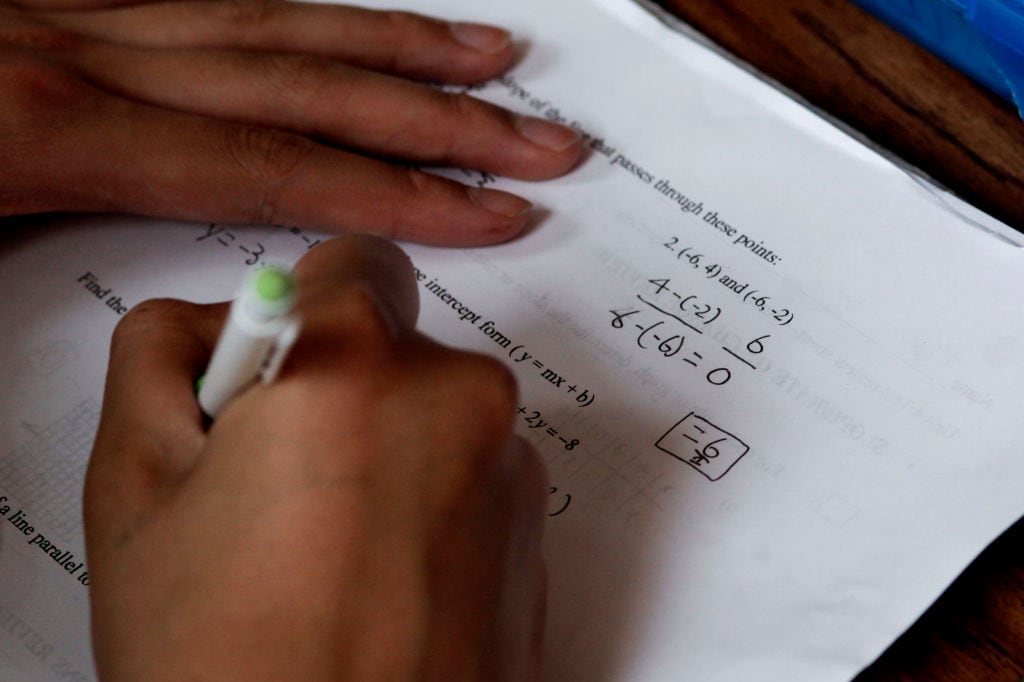Sign up for Chalkbeat’s free weekly newsletter to keep up with how education is changing across the U.S.
Girls had closed long-standing gender gaps in math test scores and were doing about as well as boys on standardized tests in the years leading up to the pandemic.
But the gender gap in math has come roaring back. And according to a new analysis from the testing and research organization NWEA, girls seem to have fallen further behind since students returned to in-person school.
NWEA also found that fewer girls were enrolling in algebra in eighth grade than before the pandemic. Because taking algebra in eighth grade sets students up to take calculus by the end of high school, it’s an important indicator of whether students will be able to pursue STEM fields in college and beyond.
The finding comes as most American students still have not recovered from the effects of disrupted pandemic learning and as the federal government is pulling back its support for research, particularly research that focuses on disparities.
The analysis draws from eighth grade scores on major international and national tests coupled with data from two million students who took NWEA’s MAP Growth Assessment.
The gender gap returned on the Trends in International Mathematics and Science Study, or TIMSS, a test given every four years in 64 countries, and on the National Assessment of Educational Progress, or NAEP, a test often referred to as the nation’s report card.
Among eighth graders who took NWEA’s assessments, boys did better than girls in math.
“All these indicators that we’re seeing across these different tests, they’re giving flashing warning signs that there’s something big happening here,” said Megan Kuhfield, director of growth modeling and analytics at NWEA and lead author of the report.
A Wall Street Journal analysis of state test scores found similar trends.
NWEA’s analysis can’t explain why this is happening. Researchers and educators have tended to focus on the ways the pandemic affected girls differently than boys. Girls’ mental health suffered more, and older girls especially took on more responsibility at home, doing housework or caring for siblings when schools were closed.
“When I first started looking at this, I thought, ‘Well, COVID changed everything,’” Kuhfeld said. “When we started digging into it, the fact that the gaps really started to widen from 2022 to 2024 more so than from 2019 to 2022, made that theory less strong to me.”
By 2022, most students were back in school. And girls continue to outperform boys in reading.
“Maybe it’s less about these global impacts on girls’ mental health and more about the classroom dynamics with students and teachers,” Kuhfeld said.
NWEA found that the math gender gap was more pronounced for higher performing students, with boys scoring much higher than girls on average. Among the lowest performing students, girls did better than boys in both reading and math.
“There needs to be a focus in middle school on making sure girls who are potentially interested in science and math get support to stay on those trajectories,” she said. “At the same time, we can’t lose sight of the boys at the bottom who are struggling.”
Research has found that teachers tend to judge math mistakes more harshly among girls and students of color and are more likely to attribute those students’ errors to lack of innate ability. Teachers who believed that gender inequality was no longer a problem were especially likely to penalize female students’ work.
“What we are finding over and over again is that when there is a mistake, when the answer is not fully correct, teachers assume that girls don’t have the math ability, or they are less capable than boys,” said Yasemin Copur-Gencturk, an associate professor of teacher education at the University of Southern California who has studied bias in teacher perceptions. “So girls could be receiving more implicit messages about not belonging in math classrooms, or they don’t have the capacity to do the work.”
Copur-Gencturk, who was not involved in the NWEA study, said it’s frustrating to see the gender gap return, but she’s glad to see data highlighting the issue. “That could be the problem and the solution, to raise awareness that it is not a done deal,” she said.
At the same time, she’s concerned that deep cuts to federal education research, and in particular to studies that touch on issues such as implicit bias and gender, mean there will be less information about what works going forward.
Algebra enrollment could be a warning sign
Kuhfeld worries that today’s gaps will grow over time. NWEA also found that fewer girls are taking eighth grade algebra than before the pandemic, which could mean fewer girls pursuing STEM majors in college. Last year, 24% of eighth grade boys and girls enrolled in algebra in the schools NWEA surveyed, but before the pandemic, 26% of girls took algebra in middle school. Boys’ participation has stayed steady.
Last year’s eighth graders were in fourth grade when schools closed in spring 2020. The years when they should have mastered foundational skills like fractions — critical to understanding algebra — were deeply disrupted.
“Eighth grade achievement is a lagging indicator for elementary school math,” Kuhfeld said. “It might mean that they’re not as prepared academically. Absent of COVID and these big changes, there’s a whole class of girls who might have been academically prepared who were routed out of these things.”
Enrollment in eighth grade algebra has been declining for years, said Elizabeth Huffaker, a research fellow at Stanford University’s Graduate School of Education and author of a brief on algebra access and placement. Curriculum changes saw more algebra content incorporated into middle school integrated math courses, making it harder to move some students ahead earlier. And “algebra for all” policies have not had the results advocates hoped for.
Girls’ absolute decline in algebra enrollment is small, and other surveys find slightly higher enrollment. But Huffaker said the decline should serve as a warning sign, especially when coupled with test score declines that defy easy explanation.
States such as Texas and North Carolina have statewide initiatives to use test scores to place students in eighth grade algebra, she said. Historically such policies have helped more girls take algebra early, but if girls now are doing worse on tests, they could have the opposite effect.
Huffaker said she would not have predicted that the pandemic would have led to widening gaps between girls and boys, and the trend deserves more investigation.
Schools should consider multiple ways of determining whether students are ready for algebra, not just test scores, she said. Tutoring and summer programs could help some students who are close to qualifying be more prepared for algebra.
But ultimately, Huffaker said, the best way to improve test scores and algebra readiness for all students, including girls, would be to make sure they learn math well in elementary and early middle school.
Erica Meltzer is Chalkbeat’s national editor based in Colorado. Contact Erica at emeltzer@chalkbeat.org.







